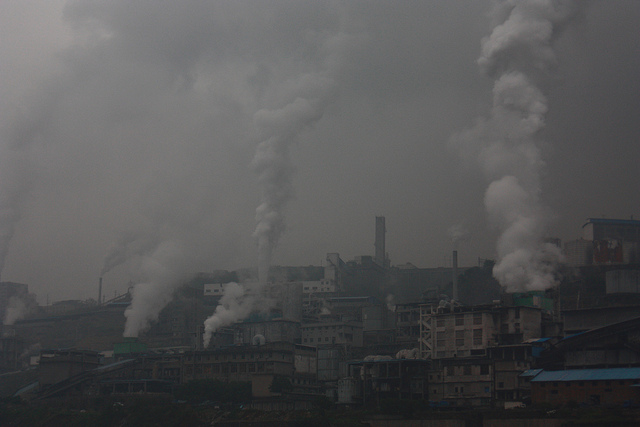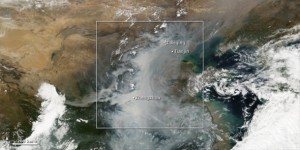Podcast: Play in new window | Download
Subscribe: RSS

It’s not just the air in China that is becoming toxic to human life, now it’s the earth itself. (Photo by Leo Fung/Flickr)
Just as China became the envy of the industrial world by achieving growth (of its gross national product) of ten percent and more per year for two decades, so its consequent collapse is about to demonstrate clearly to the rest of the world what happens when you turn your country over to unfettered greed. Stunning new evidence of the imminence of that collapse became public last week. Unfortunately, it is not just their end of the Titanic that is sinking, and it is too late to avoid catastrophe. But understanding what is happening there might help some of us survive catastrophe.
In the 1980s, with the advent of Ronald Reagan in the United States and Deng Xiaoping in China, the two countries’ leaders became as one in their dedication to making their countries havens for unfettered industry. Their new doctrine was that government was not the solution, it was the problem, and that prosperity required that government’s cold dead hands of restraining regulation be pried from the sinews of industry. Progress in America was steady but slow, because of the inconveniences of opposition parties, a (technically) free press, vigorous advocates for such things as environmental protection and human rights, and previously passed laws. China had none of those problems. It won the race, and is now disintegrating because it did.
China’s air pollution has become legendary. This fall, a blanket of dense, acrid smog over much of the country (visible from space) brought life nearly to a standstill in several major cities. People were ordered to stay indoors, factories were shut down, traffic was banned, and air traffic was snarled because pilots could not see the runways. (All of these actions were taken, of course, by government, which, as we know now, is the problem.)
Water pollution is similarly rampant. The government is secretive and defensive (remember that part about no free press), so details are hard to come by. But one reputable estimate is that 40 per cent of China’s rivers are seriously polluted, and 20% are so toxic that living things should avoid any contact with them.
Severe pollution, along with government land grabs for ever more factories, have made people throughout China ready to take to the streets, as they did this spring in Shangpu and scores of other localities, much of the conflict shrouded by government censorship.
But the worst news came last week, disguised, at least in the China Daily, as a wonderful new initiative to help people. The initiative announced is to solve a problem not previously discussed in public — a few months ago its existence was a state secret. Eight million acres of China’s prime farmland is too polluted by industrial exhaust, pesticides and animal-feed additives to grow food, and must somehow be rehabilitated. Until it is, somehow, rehabilitated, it has been taken out of production.
Imagine. This eight million acres — an area the size of Belgium — is so contaminated, primarily with heavy-metal byproducts of manufacturing and power generation, such as cadmium and mercury, that food grown on it cannot safely be eaten.
To comprehend the gravity of this, one must recall that the Chinese government’s estimate of the minimum amount of arable land required to feed the population, its “red line,” as it calls it, is 295 million acres. When you take out the eight million contaminated acres, plus the acreage recently removed by urbanization and industrialization, the Chinese are left with — 295 million acres.
The good news touted by China Daily: “Tainted Farmland to be Restored,” billions of yuan to be spent every year until the job is done. The other bad news: no one knows how to do it, and the massive expenditures will be on pilot programs, aka Hail Mary Passes.
Yes, China won the race to total industrialization that started in the 1980s. It’s going to be hard to do a victory lap, though, because the finish line was on the edge of a cliff.

And yet so many of the mainland Chinese remain jingoistic about the ‘successes’ of their ‘great’ country.
Confucius must be turning in his grave.
I think if by the year 20013 there’s still that much pollution in the air (referring to date stated for NASA image above), then the human species is truly a lost cause.